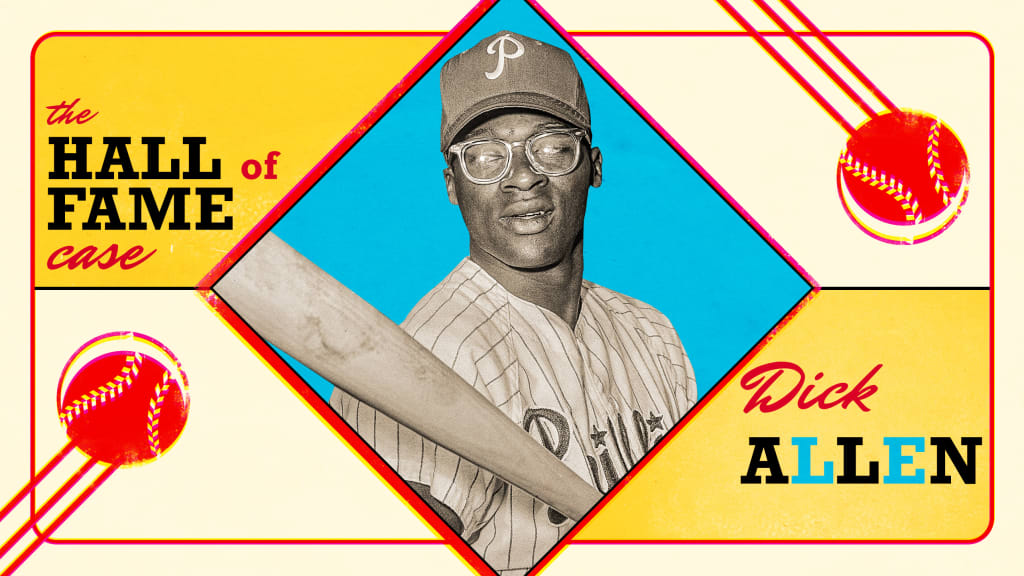
Dick Allen has not gotten his full due as one of the most ferocious -- and flat-out best -- hitters in baseball history.
Look no further than the fact that Allen, who died last December at age 78, still is not a member of the Baseball Hall of Fame. In fact, in 14 years on the ballot, he topped out at 18.9 percent of the vote -- far below the 75 percent threshold necessary for induction. While Allen fared far better when considered by the 16-member Golden Era Committee in 2014, he still came up one vote short.
Allen now has another chance, with that panel -- now known as the Golden Days Committee -- voting Sunday on the Hall’s Class of 2022. (That vote, originally slated for last year, was delayed due to the coronavirus pandemic). If Allen finally gains entry to Cooperstown, it will, sadly, be a posthumous honor.
It would also be well deserved. Allen was hardly a defensive stalwart, and he didn’t have an especially long career, which took place at a time when offense was suppressed. As such, his counting stats (1,848 hits, 351 homers and 1,119 RBIs) don’t stack up with those of the game’s great power hitters, and his career WAR (58.7) is very good but not overwhelming.
Make no mistake, though: Very few have ever been as dangerous with a bat in their hands.
Allen’s body of work was impressive
There have been 412 AL/NL hitters in the Modern Era (since 1900) who have stuck around long enough to step to the plate at least 7,000 times. For context, active players who recently reached that milestone include Andrew McCutchen, Justin Upton and Carlos Santana. The stat OPS+ provides a simple way to judge those hitters against each other, because it adjusts for factors such as ballpark and the league’s offensive environment, with an OPS+ of 100 representing league average.
Out of those 412 hitters, only a dozen finished their careers with a higher OPS+ than Allen’s 156.
That list of 12 is a who’s who of all-time legends, featuring 10 inner-circle Hall of Famers (Babe Ruth, Ted Williams, Lou Gehrig, Rogers Hornsby, Mickey Mantle, Ty Cobb, Jimmie Foxx, Stan Musial, Johnny Mize and Tris Speaker), and two sluggers who would have joined them by now if not for their ties to performance-enhancing drugs (Barry Bonds and Mark McGwire).
Two players are tied with Allen at 156, and they need no introduction. One is Willie Mays, the other Frank Thomas.
Among the many fantastic hitters coming up behind Allen on that list are Hall of Famers such as Hank Aaron, Joe DiMaggio, Frank Robinson, Jeff Bagwell, Jim Thome, Mike Schmidt, Willie McCovey and Harmon Killebrew. (The only active player with at least 2,500 plate appearances who is ahead of Allen is Mike Trout, at 176).
Of course, many of the aforementioned hitters played much more than Allen. Aaron, for example, took 6,626 additional plate appearances. Such longevity is important, and had Allen hung around the Majors for longer after his prime, he may have seen his rate stats plummet, like they have for Albert Pujols in recent years.
Still, Allen’s career numbers stack up quite favorably.
His best was elite
Following a 10-game debut with the Phillies in 1963, Allen was National League Rookie of the Year the next season, when he hit .318/.382/.557 (162 OPS+). He would go on to lead his league in OPS+ three times: with the Phillies in 1966 (181) and ‘67 (174), and with the White Sox in 1972 (199), when he captured American League MVP honors.
That was one of the great offensive seasons MLB has ever seen. Allen is one of just 16 hitters all-time to post at least a 199 OPS+ in a season of 600 or more plate appearances, and the only ones to accomplish that feat in the 48 years since are Bonds (five times), McGwire, Sammy Sosa and Jason Giambi.
All in all, Allen reached the 160 OPS+ mark in a qualifying season seven times. Just 20 hitters have done that since 1900, and only five in the Expansion Era (since 1961): Hall of Famers Aaron and Thomas, Bonds and future Hall of Famers Trout and Pujols.
He dominated his era
It wasn’t an easy time to be a hitter when Allen arrived. During his 11-season prime (1964-74), which included the "Year of the Pitcher" in '68, Major Leaguers combined to slug .368, with a home run every 44 at-bats. Contrast that with a comparable span 30 years later (1994-2004), when MLB hitters slugged .425 with a homer every 32 at-bats.
But in his time, Allen was about as good as it got. He was fifth in the Majors in homers (319) and seventh in RBIs (975) over those 11 seasons, trailing only future Hall of Famers.
Nobody in the Majors exceeded Allen’s 165 OPS+ during that period. And he outpaced a bunch of guys bound for Cooperstown, including those compared with Allen below, at fairly similar ages:
Production from 1964-74
Dick Allen: 165 OPS+ in 6,270 PA (ages 22-32)
Willie McCovey: 161 OPS+ in 5,713 PA (ages 26-36)
Willie Stargell: 153 OPS+ in 6,118 PA (ages 24-34)
Carl Yastrzemski: 145 OPS+ in 7,086 PA (ages 24-34)
Billy Williams: 138 OPS+ in 7,448 PA (ages 26-36)
Tony Perez: 131 OPS+ in 5,886 PA (ages 22-32)
Factoring in Allen’s brief debut in 1963, his 165 OPS+ over his first 12 seasons ranks 14th in the Modern Era (minimum 5,000 plate appearances). It ranks fifth since Jackie Robinson broke the color barrier in 1947, trailing only Trout, Mantle, Pujols and Thomas.
In the end, Allen didn’t extend that sensational run quite long enough to qualify for easy entry to Cooperstown. But his eye-popping peak performance, given further context by modern metrics, makes him an underrated all-time great at the plate.
